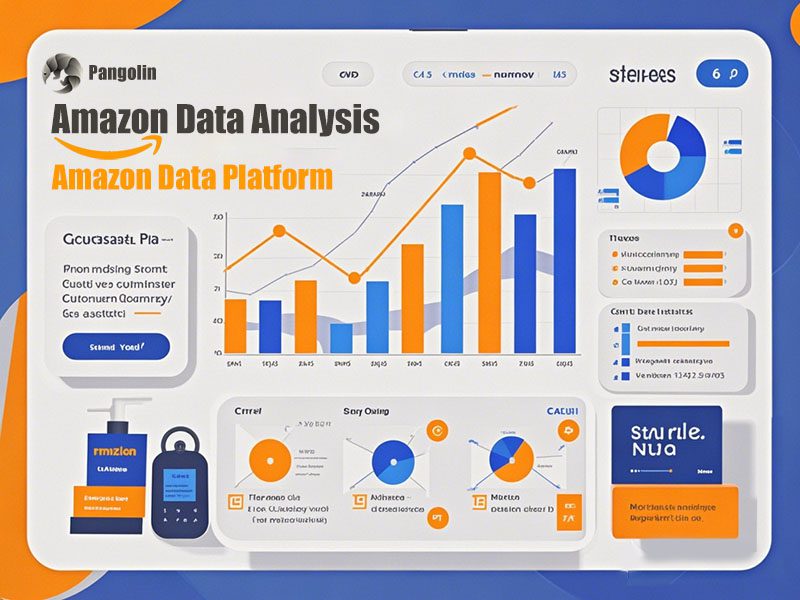Introduction
In today’s highly competitive e-commerce landscape, Amazon sellers face unprecedented challenges and opportunities. To succeed on this vast platform, sellers need more than just quality products and services; they must also rely on data analysis to make informed decisions. Amazon seller data analysis is no longer just about tracking sales—it’s about understanding market trends, analyzing competitors, and comprehending customer behavior in a comprehensive and nuanced way. This guide will provide an in-depth look at the importance of data analysis for Amazon sellers and how to utilize advanced tools and techniques to evolve from a beginner to an expert in data-driven decision-making.

The Importance of Amazon Seller Data Analysis
Data analysis is critical for success on Amazon. By delving into data, sellers can uncover insights into market demand, optimize pricing, improve advertising effectiveness, and ultimately boost overall sales performance. Data isn’t just numbers; it holds valuable information about consumer behavior, market trends, and the competitive landscape. Mastering this data allows sellers to offer the right product at the right price to the right customer at the right time.
Overview of What This Guide Will Cover
This guide will help Amazon sellers understand the basics of data analysis, explore core areas of focus, and learn how to turn insights into actionable strategies. We will also introduce key data tools and services, including Pangolin Data Service, which can make the process of data analysis more efficient and effective.
Amazon Seller Data Analysis Basics
What is Data Analysis? Why is it Crucial for Amazon Sellers?
Data analysis involves collecting, processing, and interpreting data to extract valuable insights that support decision-making and strategy development. For Amazon sellers, data analysis means gaining a deeper understanding of market dynamics, consumer demand, and product performance, enabling more targeted business decisions. Whether it’s choosing new products, optimizing inventory management, or developing marketing strategies, data analysis is an essential part of the process.
Key Data Metrics Explained
Understanding and mastering the following key metrics is crucial for effective data analysis:
- Sales Volume: Indicates the number of units sold within a specific time frame, serving as a foundational metric for assessing product popularity.
- Conversion Rate: Shows the percentage of visitors who make a purchase, a vital indicator of product page performance and advertising effectiveness.
- Best Seller Rank (BSR): Reflects a product’s sales performance within a specific category on Amazon. The higher the BSR, the better the product is selling in its category.
- Customer Reviews and Ratings: Directly reflect customer satisfaction and trust, significantly influencing subsequent purchase decisions.
- Average Order Value (AOV): Represents the average amount spent per order, helping sellers understand customer spending habits and purchasing power.
By mastering these key metrics, sellers can dive deeper into sales trends, market opportunities, and product positioning to develop more competitive strategies.
Data Sources: Where to Obtain Amazon Data?
Amazon Seller Central
Amazon Seller Central is the primary platform for sellers to access most of their basic data. Through Seller Central, sellers can access sales reports, inventory levels, order information, and customer reviews. While these data points provide foundational business insights, more complex market analysis and advanced strategy development often require more comprehensive and detailed data.
Amazon Advertising Platform
The Amazon Advertising Platform offers detailed data related to advertising, including impressions, click-through rates, conversion rates, and ad spend. This data helps sellers optimize their ad campaigns, enhancing ad performance and return on investment (ROI). By analyzing advertising data, sellers can identify the most effective keywords and ad creatives, making adjustments based on results.
Public Market Data
In addition to Amazon’s internal data sources, public market data provides valuable market intelligence. Through market research reports, industry analyses, and third-party market monitoring tools, sellers can gain insights into competitors’ sales performance, market trends, and consumer preferences. This external data provides a broader perspective, helping sellers better understand the market environment.
Third-Party Data Tools and APIs
To obtain more comprehensive and real-time data, many Amazon sellers turn to third-party data tools and APIs. These tools often collect more detailed market information and offer powerful data analysis capabilities. For example, Pangolin Data Service is a reliable third-party data source that provides a range of products, including Scrape API, Data API, and Pangolin Scraper. These tools offer full-site data collection, real-time parsed data, and visual data collection solutions, helping sellers meet various levels of data analysis needs.
- Scrape API: Ideal for sellers requiring large-scale data collection, enabling rapid extraction of raw Amazon webpage content for custom data parsing.
- Data API: Provides structured, easy-to-understand parsed data, eliminating the need for complex web scraping and allowing users to directly access and analyze data.
- Pangolin Scraper: Offers a visual data collection service, exporting data in Excel format, making it perfect for users who need straightforward data processing.
By combining these tools, sellers can significantly enhance their data analysis capabilities, enabling them to better seize market opportunities.
Core Data Analysis Areas
Sales Performance Analysis
Sales performance analysis is the most fundamental and essential part of data analysis. By analyzing sales data, sellers can understand product sales trends, seasonal fluctuations, and the contribution of various sales channels. This analysis helps sellers better grasp market demand and formulate reasonable production and procurement plans.
In sales performance analysis, Pangolin Data Service’s Data API provides sellers with comprehensive data support. Through this API, sellers can easily access various sales-related data, allowing for more accurate sales analysis.
Product Performance Analysis
Product performance analysis involves a detailed examination of individual products, including their market performance, customer feedback, return rates, and performance in different markets. This analysis helps sellers identify which products are most popular, which need improvement, and when to launch new products or discontinue existing ones.
For product performance analysis, Pangolin Data Service’s Scrape API can help sellers quickly obtain the necessary raw data and perform in-depth analysis according to their needs, ensuring data accuracy and timeliness.
Pricing Analysis
Pricing competitiveness directly impacts sales performance on e-commerce platforms. Pricing analysis allows sellers to monitor competitors’ pricing strategies, adjust their own pricing strategies, and ensure market competitiveness while maintaining profitability. Pricing analysis involves not just price comparison but also considering factors like cost, market demand, and competition.
Pangolin Data Service’s products can support pricing monitoring and analysis, helping sellers adjust pricing strategies in a timely manner. Pangolin Scraper can be used to export competitors’ pricing data in Excel format, facilitating detailed price comparison and trend analysis.
Inventory Management Analysis
Inventory management is a critical area of e-commerce operations. Stockouts can lead to lost sales, while overstocking increases storage costs. By analyzing inventory management, sellers can optimize stock levels, reduce costs, and ensure product availability.
Pangolin Data Service’s data services can help sellers monitor inventory in real-time and predict future inventory needs, ensuring efficient inventory management.
Customer Behavior Analysis
Customer behavior analysis is key to understanding consumer needs and preferences. By analyzing customers’ purchasing behavior, browsing habits, reviews, and feedback, sellers can better understand consumer psychology and optimize products and marketing strategies.
In customer behavior analysis, Pangolin Data Service’s tools can also provide effective support, helping sellers acquire detailed customer data and conduct multi-dimensional behavior analysis.
Advanced Data Analysis Techniques
Predictive Analysis: Sales Forecasting and Trend Prediction
Predictive analysis is an advanced data analysis technique that involves analyzing historical data and current trends to forecast future sales and market trends. This analysis helps sellers plan ahead and gain a competitive edge. For example, based on historical sales data and market trends, sellers can predict peak sales periods during specific seasons or holidays, allowing them to prepare adequate inventory and marketing strategies in advance.
Pangolin Data Service’s advanced analytics features support complex predictive analysis, helping sellers easily forecast market trends and estimate sales volume through multi-dimensional data processing.
Competitor Analysis: Market Share and Positioning
Competitor analysis is essential for sellers to develop market strategies. By analyzing competitors’ market share, product positioning, pricing strategies, and customer reviews, sellers can identify their strengths and weaknesses and adjust their market strategies accordingly. This analysis not only helps understand the competitive landscape but also helps sellers identify potential market opportunities.
Pangolin Data Service provides powerful support for competitor analysis, allowing sellers to use its data services to obtain detailed performance data on competitors and conduct in-depth analysis.
A/B Testing: Optimizing Product Listings and Ads
A/B testing is a common optimization strategy that involves simultaneously testing different versions of a page or ad to compare their performance and determine the best option. For Amazon sellers, A/B testing can be used to optimize product listings, ad copy, images, and pricing.
Pangolin Data Service’s advanced analytics features support various A/B testing scenarios, providing precise data feedback to help sellers quickly identify the optimal solution.
Data Analysis Tools and Software
Free Tools: Excel, Google Sheets
For beginners in data analysis, Excel and Google Sheets are the most basic and commonly used tools. They offer essential data organization, analysis, and visualization features suitable for handling smaller datasets. However, as data volume increases and analysis needs become more complex, free tools may not suffice, and more professional data analysis software may be required.
Paid Tools: Tableau, Power BI
Tableau and Power BI are two widely used paid data analysis tools that offer powerful data visualization and analysis capabilities. These tools allow sellers to easily create complex charts and reports and perform in-depth data mining and analysis. They are suitable for medium to large enterprises and sellers with more advanced data analysis needs.
Professional Amazon Data Analysis Platforms
In addition to general data analysis tools, data analysis platforms specifically designed for Amazon sellers are gaining popularity. These platforms typically integrate Amazon-specific data metrics and analysis features, enabling sellers to conduct e-commerce data analysis more efficiently.
Pangolin Data Service offers three professional Amazon data analysis products:
- Scrape API: This tool supports full-site data collection, making it ideal for sellers who need deep analysis. Scrape API allows sellers to obtain raw Amazon page content and customize data parsing.
- Data API: This tool provides parsed Amazon data, supporting real-time data acquisition and analysis. Its structured data output format greatly simplifies data integration and processing.
- Pangolin Scraper: This tool combines the advantages of Scrape API and Data API, offering visual data collection and processing capabilities suitable for users of different technical levels.
By combining these tools, sellers can enhance their data analysis capabilities from data collection to in-depth analysis, driving business growth.
Data-Driven Decision Making: How to Turn Analysis into Action
In e-commerce operations, the ultimate goal of data analysis is to turn insights into actionable strategies. Whether adjusting product pricing, optimizing ad campaigns, or improving customer service, data-driven decisions help sellers more accurately meet market demand and increase operational efficiency.
For example, using Pangolin Data Service’s pricing monitoring feature, one seller successfully identified a competitor’s pricing strategy and adjusted their own pricing, resulting in a 15% increase in sales while maintaining profit margins.
Common Pitfalls in Data Analysis and How to Avoid Them
While data analysis plays a crucial role in e-commerce operations, sellers can easily fall into common traps during the analysis process, such as:
- Data Overload: With a vast amount of data available, sellers can become overwhelmed, making it difficult to extract valuable insights. The solution is to clearly define analysis goals and focus on key metrics.
- Misleading Correlations: Correlations between data points do not necessarily indicate causation. Sellers should interpret data results carefully and avoid over-interpretation.
- Ignoring Data Quality: The accuracy and completeness of data are the foundation of analysis. Sellers must ensure that the data used is current and reliable.
These pitfalls can be effectively avoided with the right approach and tools. Pangolin Data Service offers tools that simplify the data processing process, ensuring data accuracy and actionable insights.
Case Study: How Successful Amazon Sellers Use Data Analysis
Successful Amazon sellers often prioritize data analysis and leverage data-driven strategies to gain a market advantage. For example, a well-known electronics brand used Pangolin Data Service’s market trend analysis feature to successfully predict the rise of an emerging product category. By planning ahead, the brand captured 20% of the market share within three months of the new category’s launch.
This case study demonstrates that data analysis can help sellers optimize current operational strategies and provide strong support for future market expansion.
Future Trends: The Direction of Amazon Data Analysis
With the development of artificial intelligence and big data technologies, Amazon data analysis will become more intelligent and precise. Future trends include:
- Intelligent Data Analysis: AI technology will further integrate into the data analysis process, automating data processing and predictive analysis to help sellers make faster decisions.
- Real-Time Data Analysis: Real-time data acquisition and analysis will become the norm, allowing sellers to adjust strategies immediately in response to market changes.
- More Detailed Personalized Analysis: Personalized recommendations and customized marketing strategies based on user behavior will further enhance sellers’ competitiveness.
Conclusion
Achieving success on Amazon requires more than just quality products and services—it also requires making informed decisions through data analysis. By following this guide, sellers can master everything from basic data analysis to advanced techniques, enhancing their competitiveness on the Amazon platform.
Additional Resources
If you want to further enhance your data analysis capabilities, visit Pangolin Data Service at www.pangolinfo.com for a free trial. You can also connect directly with our data experts via email at [email protected] to learn more about customized solutions. With Pangolin Scraper, you can get 300 free test points and free trials of our other two products, helping you take your Amazon business to the next level.






